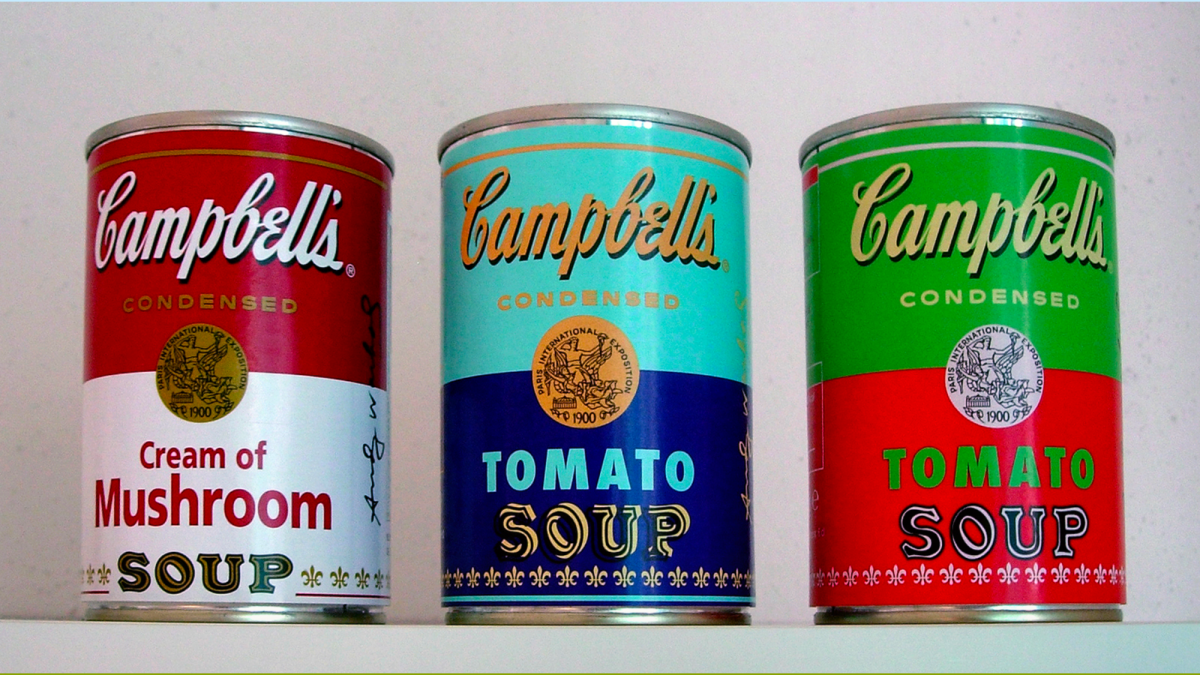Ice-Breakers & Fun Group Games

The BEST Ice-Breakers & Getting-To-Know-You Games
Are you looking for a bunch of GREAT ICE-BREAKERS?
Do you need to build a little energy in your team / classroom / training room / youth group?
Perhaps you need some advice to help you break through the ice?
Then, this is the space to visit.
This lens features everything about HOW TO PRESENT really fun ICE-BREAKERS & GETTING-TO-KNOW-YOU GAMES & ACTIVITIES. Dozens of ice-breaker and energiser game descriptions, tons of variations, leadership tips and lashings of inspiration to help you look like a pro!
Have FUN!

Things I've Learned Along The Way
My Programming Pearls of Wisdom
Many years ago, I started to record a list of all the activities I had been exposed to - mostly as a participant - during my Project Adventure training experiences. Reflecting my fastidious inclinations, I grouped like activities together, so that as the list grew longer and longer, I would find it easier to access them when I needed a good idea. Ice-breakers, de-inhibitizers, warm-ups, initiatives, trust exercises, games - I recorded the lot.
Twenty plus years later, the list has grown into what I refer to now as my "Book of Tricks," or, when feeling particularly enamoured, my "bible." There are simply hundreds of great activity ideas contained between its seriously dog-eared covers.
Yet, as much as it represents a chronicle of what I have played over the years - and continue to draw benefit from - it would fail to inform even the most learned of my colleagues the slightest glimpse of what I have discovered along the way. And, most importantly, what I believe to be more significant than the games themselves.
As I flick through its pages, I know for a fact that my briefing and presentation skills, and my understanding of many of the earliest recorded activities has changed significantly - for the better - since I first learned them. It's true, I have added many new and wonderful variations to my list of games, but this is not the difference I speak of. Rather, I refer to the philosophies and general comprehension of how play can develop positive relationships that now envelops my facilitation style and overall program delivery approach.
As a senior international trainer for Project Adventure, I often muse about these differences for the benefit of training participants. Now, I think it's time to write them down.
At a glance, here are my twelve MOST IMPORTANT PEARLS OF WISDOM. Each month, I'll add further modules to this lens (below) to expand on each of these useful insights.
1. Frame Your Experience
2. It's All In How You Say It
3. Inject Lots Of Humour
4. Let The Group Create Its Own Energy
5. How Not To PIck A Partner
6. Always Ask For A Volunteer
7. Have More Up Your Sleeve Than You Need
8. Stop An Activity Before It Wanes
9. Walk Your Talk
10. Play On - Don't Eliminate People
11. Keep People Bunched Together
12. Seek Feedback All The Time
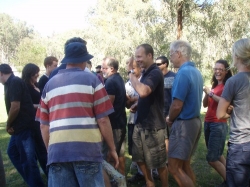
1. Frame Your Activity
Programming Pearls of Wisdom
In other words, prepare, prepare, prepare.
Appropriately framing an activity - that is, to "set the scene", or provide a context in which the activity will take place - is one of the most valuable tools I employ to help groups achieve their goals, ie get success. Otherwise, your group may not be ready - in most cases, emotionally under-prepared - for what is about to happen.
People have a natural proclivity to want to know why they are doing what they are doing. Framing goes a long way towards answering these questions, as well as reducing anxiety, providing clarity, and generally coaxing people forward into your program.
Everything you do programmatically provides the context in which the next activity is framed. For example:
(i) Your language - it's not just what you say, but how you say it - check out the next paragraph for a more thorough discussion;
(ii) Lead-up activities - like building blocks, every activity should aim to complement the next, rather than subvert it. To illustrate, leading into a serious discussion with a very energetic, bounce-off-the-wall type of activity is unlikely to result in a settled, composed or focused group of people.
(iii) Your general approach to facilitation - if you operate under the premise of "challenge by choice," but your overall demeanour says there is no choice, you are likely to turn people off.
Ask yourself, "Have I done everything to prepare my group - emotionally, mentally and physically - for this experience?" "Do they know what they are getting into, and why?" If not, think about what lead-up activities you could use to prepare thy way, or perhaps what introduction / briefing might be necessary to soothe the group into the activity.
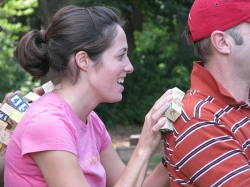
2. It's All In How You Say It
Programming Pearls of Wisdom
As a participant, which would you prefer to hear?
"... and if you're too slow, or get the wrong answer, you are "out" and you have to come in to the centre of the circle ... "
Or, "... and if the time expires, or you make a gaffe, you are invited to take your turn in the centre of the circle and have some fun ..."
Perhaps each statement is saying the same thing, but for many people, they will hear a big difference. The first implies that I have no choice ("you have to"), so I might feel under pressure because I don't want to be "slow" or "wrong". This may manifest itself as, I don't want to make a mistake, so perhaps I won't play. While the second statement is all about options (you may decline the invitation), and fun introduced as an integral part of the consequence of "going out".
As a program provider, our language is one of our most potent tools. It can work for us or against us, and I don't just mean the use of "politically correct" terms. Beware that everything you say, from the moment you introduce yourself to the waves good-bye at the end will fan the flames of invitation and play, or snuff it out.
Ask yourself, "Have I introduced this activity in the most appealing, inclusive, way? Provide choices to people so that they can find a level of participation that is comfortable for them.
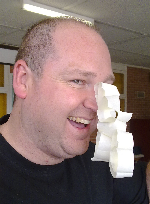
3. Inject Lots Of Humour
Programming Pearls of Wisdom
This is such a critical element of my delivery, and to be honest, the trick to opening up my group.
Observe the crazy, menial little things people do, and serve it back to them in a manner that says have you ever noticed this? Of course, they have, they just don't want to admit it.
For example, the insistence some people have for tagging another after you have stopped the game, or the understated crawling on knees when a simple pivot in place was called for. Or, at a more serious level, the subtle glance over the shoulder to check that your spotters really are there behind you to catch your fall, even though the command "ready, fall away" was given. What about the way we (notice, I'm using the royal "we" here, so as to not draw attention to myself) divert our eyes and attention away from someone we have met, learned their name, but now that they are coming our way, can not for all the rice in China remember it? I could go on and on...
Suffice to say, people love this stuff - it was the essence of the TV show "Seinfeld". Our programs are made up of so much normalness, perhaps nothingness, it can be hilarious to sit back and look at it for what it really is at times. Of course, how you deliver these moments is key - what could appear to some as a diamond in the rough, may just be a rock to others. Focus your humour so that you encourage your group to laugh with rather than at others.
Oh, and inject tons of FUNN (Functional Understanding Not Necessary) too - it will act as a magnet for many more moments of people simply being human!

4. Let The Group Create Its Own Energy
Programming Pearls of Wisdom
Having just encouraged you to inject lots of humour, I have to admit, that some groups just don't get it.
You can lay out the most fun, most inviting program ever, and yet, they still won't come to the party. In the early days, a typical reaction from yours truly to this scenario was to work even harder, and generate the energy myself that I was looking to draw from the group. Then, after "hitting the wall" on several occasions, I finally got it.
Give yourself and your group permission to discover their own energy.
It will be different for every group, and provided you have created a caring and supportive environment within which to play, wherever the group is at, is where the group is supposed to be. End of story.
Sure, pepper your program with a little more FUNN, add a little levity, but do not generate the energy for the group solely on your own efforts. You will burn yourself out way too quickly, and importantly, you will cheat (read, disempower) your group the opportunity of being the cause of it's own outcomes.
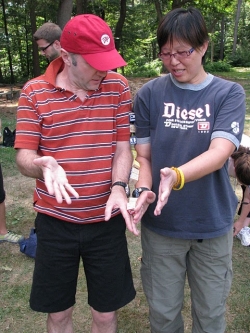
5. How NOT To Pick A Partner
Programming Pearls of Wisdom
Have you ever noticed how the seemingly innocuous words "Okay, everybody pick a partner..." can strike terror into the hearts of many participants? In my experience, it is one of the most frightening things you can ask a group to do.
Questions such as "Should I pick someone, or wait to be picked?", "What if I pick somebody, and they don't want to play with me?", "Does she really want to play with me, or is she just being nice", or "If I pick him, will he think I'm coming on to him?" will be roused among many others.
Sadly, the instruction to "pick a partner" is too-oft interpreted as "find someone you are attracted to." This thought is as embarrassing as it is open to the anxiety-laden prospect of people feeling left out. There are just too many other ways to ask people to get into smaller groups, including pairs, to risk these outcomes.
Now, I'm not suggesting that you should never use the words "pick a partner" again. Certainly, as a program develops and your group becomes more comfortable with each other, the panic-inducing reaction to simply "picking a partner" will diminish. But, with most groups, especially if they have just met each other, you are well advised to avoid the typical "pick a partner" suggestion.
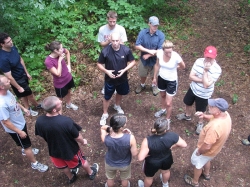
6. Always Ask For A Volunteer
Programming Pearls of Wisdom
There is always, no matter how long you wait, always someone willing to step into the ring of fire, and help you do whatever you need.
Perhaps you need help to demonstrate the next move, or need someone to break the ice and start the activity, whatever – it never fails, there is always someone willing to step forward.
But why bother, when you can often save time and potential embarrassment by doing it yourself, or asking a colleague to step in? The value is hidden in the invitation.
It can be as simple as observing the initial humour of no-one stepping forward, or everyone but one poor soul stepping back. However, beyond the humour, there is extraordinary value in using a volunteer from your group. Having one or more of your group step forward says “I am willing to…” take a risk, have fun, give it a go, look silly, etc, etc. These are huge transformative messages that are broadcast loud and clear – yet subtly - to the rest of the group. It will frequently open up further opportunities for more of this, from more of your group.
Asking for volunteers is part of the fun, it’s suspenseful (“what’s he/she gonna do?”), and it’s a true adventure, especially if you don’t telegraph what they are going to be doing. Besides, I get to be up-front all the time, I want to share the limelight from time to time.

7. Have More Up Your Sleeve Than You Need
Programming Pearls of Wisdom
You can never have too many activities lined up in your head, nor too much equipment at the ready. This could be just another way of saying "be prepared", but it's more than that. It's about options.
Stuff happens - the bus arrives late, it starts to rain, the room is smaller than you anticipated, a member of your group is nursing an injury or disability, etc, etc - all of these events call for immediate attention. Sometimes, it may be just as simple as getting to the end of your activity list, and realising too late that they ran for much less time than you had imagined.
I can't tell you the number of times I have been 'saved' from that menacing what-are-we-going-to-do-now look by resorting to Plan B, C or D, and making it look like I had it all planned from the start. It's always better to say "….gee, I didn't get to do half of what I wanted, or planned, etc", than , "…arghhhh, I need to think of something quick…". It makes you look good too!
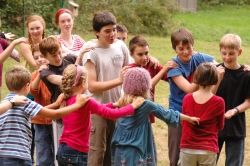
8. Stop An Activity Before It Wanes
Programming Pearls of Wisdom
Leave them wanting for more. Stopping an activity just as it reaches its peak, and perhaps a tad further will give you many useful programmatic starting points. Moving on at this juncture keeps the energy of the group up, and their spirits high.
It's always easier to slide into the next activity if you have their attention, even if they are complaining that you stopped too soon. Better this than having no complaints because everyone left the scene on account of eventual boredom!
You can always go back to the activity if it really is that good (and it fits your program goals), but it's often better to move onto something new while you have them in the palm of your hand.
And remember, quoting the evangelical words of Karl Rohnke, if at the end of the day you have waned more often than you waxed, get a new job.
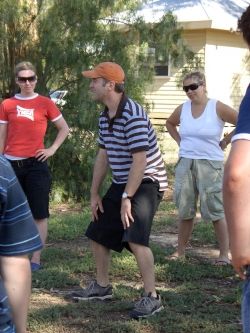
9. Walk Your Talk
Programming Pearls of Wisdom
Example is a powerful cause in people’s life. If your group sees you do the very thing you are asking them to do, they are more likely to take it on. This is one of the primary reasons I love my work, because I get to play and join in on the fun, rather than stand back all the time.
But more than just participating, walking your talk embraces everything about your program and who you are to your group – from the language you use and encourage, to the choices you make and respect - it all matters.
If you can mix it with your group (when it is appropriate) and demonstrate that you are prepared to take risks (for example, in the challenges you set, and the types of activities you use), your example will inspire your group to have fun and take risks too.
Naturally, there are times when you need to step back, and let your group play and learn on their own. However, accept that some groups like nothing more than to see their teacher, leader, coach, whomever, do the activity with them.
One further nudge – I surmise that about 95% of the activities I know and deliver I have learned through actually 'doing' them. Be it as a participant of someone else’s program, or I play out for real an activity I’ve just picked up from somewhere (ie a book or a peer), pretty much all of the activities I do, I have learned as a participant.
I also strongly believe that this experience – knowing what it’s like to be a participant in the activity (as distinct from being the leader) – will make you a much better facilitator of the activity. Actual get-your-hands-dirty participation will give you direct knowledge of what it’s like to be a participant in the activity – which no book or learned colleague’s stories about a new, you-beaut activity could ever substitute. It will also keep you fresh, you know, in a way that reminds you what it’s like to be a participant again.
And if all of this has failed to impress you to walk your talk, just do it for the fun.
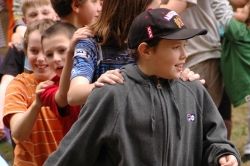
10. Play On - Don't Eliminate People
Programming Pearls of Wisdom
Ever been left out of a group?
Ever felt that everyone else was having fun, but you weren't?
You're not on your own - I've been there, and done that, especially when I was younger. So I make it a point not to introduce too many activities that eliminate people, especially early in a program.
Games which eliminate folks can be great fun; I still use many of them. But when used at the wrong time (eg, too early as the group is forming), or in the initial stages of a group's development, I risk alienating certain people, not to mention losing a lot of useful energy.
Also, it is not unusual to watch the same people get eliminated over and over again. Beware what message this may send to the group - and the individual - if this does not occur within a safe and supportive atmosphere.
Clearly, the more people you have involved, the more energy and good times you can develop - which is my next point....
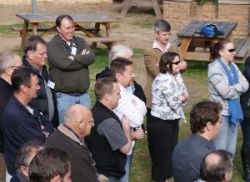
11. Keep People Bunched Together
Programming Pearls of Wisdom
The wall-flower syndrome - you know, those folks who like to stand with their backs to the wall - is such a killer of energy and enthusiasm, especially in the beginning stages of your program (when it seems everyone is reading the same script). Always invite people to come closer to you, get them to bunch up a little. Circles work fine, but when you don't need a circle, collapse them in, and invite them to move closer to you. You and they will bristle with energy, which is a wonderful way to kick-off.
My style is very much "hey come over here I've got a secret to tell". People move in, they lean closer, their attention is piqued. I love that. They are now primed, and ready to rock-n-roll. Yet, at the same time, your group has started to unconsciously break down some barriers, not to mention, trust and share which are all good.
Try speaking a little softer, that often works a treat. Your group will have to bunch up together simply to hear you. And all those folks who can't hear you because they are too busy talking, will suddenly gasp when they realise the group has gone quiet! I love the humour of that moment too.
Oh, there is just one caveat - never ask a very large group of over-enthusiastic children standing in a circle, to take a few steps into the centre towards you- before you know it you will be under the biggest pile of "stacks on the mill" you've ever had the back-breaking pleasure to be a part of.
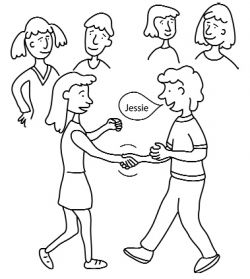
When Is An Ice-Breaker NOT An Ice-Breaker?
Why Your Opening Exercise Didn't Work
Most people think that simply adding an activity to the beginning of a program makes it an ice-breaker.
Wrong!
To truly qualify as an ice-breaker, an activity (or any experience) MUST reflect most, if not all, of the following five criteria:
1. It must be fun;
2. It must be non-threatening;
3. It must be highly interactive;
4. It must be simple and easy to understand; and
5. It must be success-oriented.
So, if an activity or experience you are considering does not tick off 3, 4 or (hopefully) all 5 of these attrtibutes and you're calling it an "ice-breaker," don't do it!
I have more to explain, but first, let's agree first on what an ice-breaker is aiming to achieve.
What Is An Ice-Breaker?
In short, an ice-breaker aims to break the "ice" that typically limits or inhibitis the interactions of a group of people who may or may not know each other very well. Common occurrences of "ice" may include little or no talking, poor eye contact, reluctance to make physical contact, lots of standing around, lack of initiative, absence of trust, etc.
A good ice-breaker acknowledges these facts, and intervenes. When presented appropriately, with full regard to the needs of the group, an ice-breaker will reduce, minimise (and hopefully eliminate) the impact of the "ice" and invite the group to create a more productive atmosphere, one that is conducive to working together or achieving whatever the purpose of the group is.
In essence, an ice-breaker PREPARES the group for its purpose. Without this necessary prep, the group is less likely to be as "successful" as it could.
So, this brings us back to what makes an ice-breaker an ice-breaker. Simply putting an activity or game at the start of a session does not constitute it as an ice-breaker.
An illustration - how often have you sat in a room, and at the behest of the leader / teacher / instructor, waited in turn as everyone stood up and introduced themselves? OMG. Heaps of times, I bet. And I would also wager that the "leader" would have labelled this exercise as their nominated "ice-breaker." Wrong! Why? Because, while relatively simple to understand, this poor excuse for preparation is rarely fun, it is never success-oriented (most people are thinking of what they are going to say, and not listening to anyone else), it is very threatening (especially to those who are not prepared to speak in front of others) and is about as far from highly interactive as you can get. It's not an ice-breaker - it's simply an indication that the presenter doesn't know how to kick off his / her session effectively.
Do you see what I mean? An ice-breaker is ONLY ever an ice-breaker when it truly breaks the ice. And this result can only ever be achieved when the exercise (or experience) invites tons of simple, non-threatening, success-oriented, interactive fun.
The following are all good examples of ice-breakers - using a fun, interactive name-game to help a new group of people get to know one another, showing a powerpoint presentation to frame a forthcoming experience, and smiling and shaking the hand of every participant as they enter your training room. If the activity / exercise / experience successfully prepares your group for what is ahead, then it is more likely to be considered an effective ice-breaker.
Final word...
Now, keep in mind that my discussion here does NOT suggest that an ice-breaker has to be a game or activity. My focus here is solely on producing a particular result. ANY experience, including games and activities, but also simple conversations, introductions, etc, can achieve this result.
So, when you think "ice-breaker," think of what 'experience' you could introduce that would effectively break the ice. One of the tools at your disposal is a quick game or exercise, but you could equally introduce another form of preparation to achieve your desired result.
I just happen to believe that ice-breakers which represent the form of games and activities are particularly useful, because they are engaging, fun and very transferable. And that's why this lens is focused on these types of experiences.
Have fun!
Recommended Activity Publications
This is just a short list of activity publications that I HIGHLY recommend you get your hands on. If you're serious about adding tons of fun and value to your programs, then you can't go past these titles.
Also take a look at playmeo.com for more great resources.





Recommended Links - Resources I Think You Should Know About
- Serious Fun: Your Step-by-Step Guide to Leading Remarkably Fun Programs That Make A Difference
The step-by-step guide to help you run amazingly successful group games and activities with any group, by Mark Collard, experiential trainer, author and keynote speaker. - Online Activity Database - Ice-Breakers & Getting-To-Know-You Activities
The world's most comprehensive online database of play & adventure-based activities which are fun, universally appealing and easy to use. Ideal for teachers, corporate trainers and other program leaders. - Free eBook - Sure-Fire Ice-Breakers & Group Games
Ten of the most successful ice-breakers and group games, written by Mark Collard. Instant free download. - No Props: Great Games with No Equipment
Top-selling activity book featuring 300 of the most successful ice-breakers, energisers, co-operative games, trust exercises and team-building activities. 220 pp, printed in Australia, published by Project Adventure. - Count Me In: Large Group Activities That Work
Top-selling activity book featuring 300 of the most successful large group activities, including ice-breakers, energisers, co-operative games, trust exercises and team-building activities. 260 pp, printed in Australia, published by Project Adventure.
If you have a question you'd like to ask me, even if you think it's really silly - please ask... I'd be only too happy to respond and help you out...








